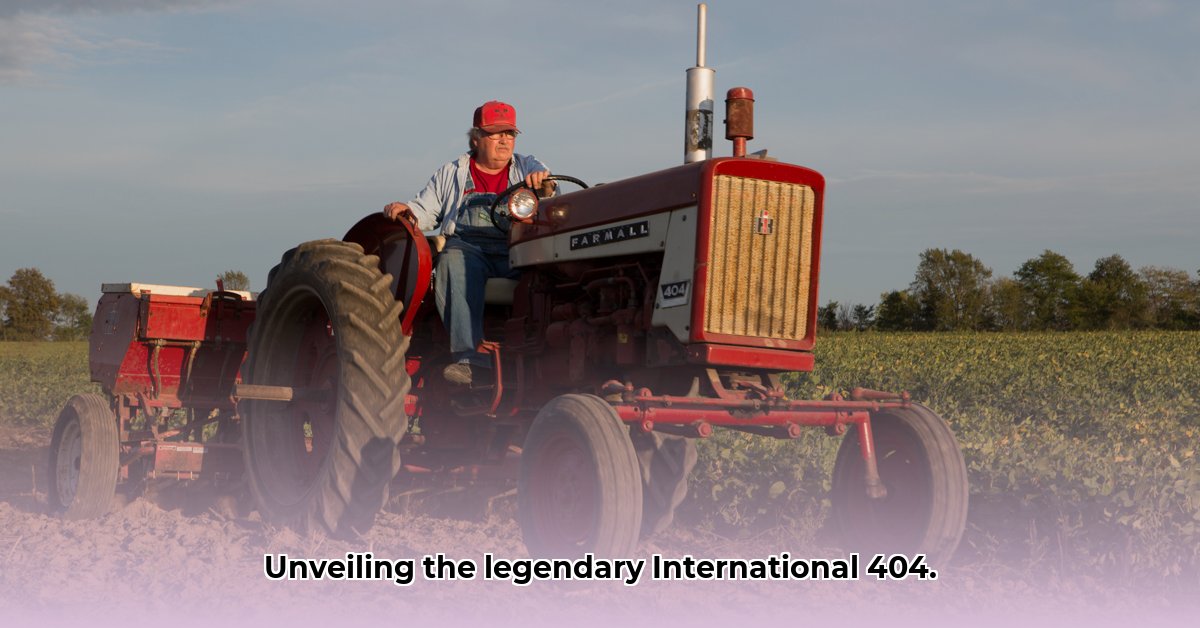
The International 404 tractor, produced from 1961 to 1968, represents a significant chapter in agricultural mechanization. This article delves into its technical specifications, production history, and lasting impact on farming practices. Understanding its nuances—from engine choices to transmission options—reveals the design philosophy behind this versatile workhorse. For more on vintage tractors, see this site.
Under the Hood: Power and Fuel Flexibility
The International 404 was powered by International Harvester's C-135 engine, a 2.2-liter four-cylinder unit. This engine offered farmers a choice between gasoline and liquid propane (LP) gas fuel. This fuel flexibility was a considerable advantage, allowing farmers to adapt to fluctuating fuel prices and availability. While precise horsepower figures vary across sources due to differing testing methodologies, the engine provided sufficient power for a broad range of agricultural tasks. Were these variations significant in daily operation? Further research is needed to definitively answer this question.
Chassis Variations: Row-Crop and Utility Models
International Harvester offered two primary chassis designs: row-crop and utility. The row-crop version, often marketed as the Farmall 404, was designed for maneuverability in close-quarters situations, such as navigating between rows of crops. The utility model, in contrast, offered greater versatility for a broader range of tasks. This dual-chassis approach reflects International Harvester's commitment to providing farmers with tailored solutions. How did this design choice impact the tractor's overall market appeal? The answer likely lies in analysing sales records from the period.
Transmission Options: Tailored to Farmer Needs
Adding to its adaptability, the International 404 offered a selection of transmissions. Farmers could choose between 4-speed and 8-speed options, further enhancing operational efficiency. Power steering was also available, a feature that significantly reduced driver fatigue during extended periods of operation. This customizability was a key factor in the tractor's widespread adoption. A comparison of the operational costs between the 4-speed and 8-speed models could reveal the financial implications of this tailoring.
Key Features and Design Details
Both the Farmall 404 and the International 404 shared core features. These included reliable mechanical disc brakes and an open operator station—a common design aspect of the era. An optional International Harvester 2001 front-end loader was available, increasing the tractor's overall utility. However, subtle differences between the row-crop and utility models existed, primarily concerning chassis design and weight distribution. These differences highlight the meticulous engineering invested in each variant. Original International Harvester service manuals remain invaluable in documenting these minute details.
Production and Legacy: A Lasting Mark on Agriculture
The International 404 was produced from 1961 to 1968 in Louisville, Kentucky. Estimates suggest production numbers exceeded 2440 units. While precise yearly figures remain elusive due to the limitations of historical record keeping, the tractor's success is undeniable. It became a symbol of its era of farming and a testament to the reliability of International Harvester's engineering. The durability of the 404 is frequently discussed in online forums dedicated to vintage tractors.
Specification Comparison: Row-Crop vs. Utility
The table below summarizes the key specifications of the Farmall 404 (row-crop) and International 404 (utility) models. It's crucial to note that some variations may occur due to differences in reporting, sourcing, and production year.
| Feature | Farmall 404 (Row-Crop) | International 404 (Utility) | Notes |
|---|---|---|---|
| Engine | IH C-135 | IH C-135 | 2.2L, 4-cylinder; gasoline or LP gas fuel |
| Transmission | 4-speed or 8-speed | 4-speed or 8-speed | Manual transmission; power steering optional |
| Brakes | Mechanical Disc | Mechanical Disc | |
| Operator Station | Open | Open | No air conditioning |
| Front-End Loader | Optional (IH 2001) | Optional (IH 2001) | Increased versatility for various tasks |
| Primary Use | Row crop farming | General farm work | Chassis design optimized for specific tasks |
Nomenclature Clarification: Farmall 404 and IH 404
The Farmall 404 and the International 404 are fundamentally the same tractor. The name change reflects a broader rebranding strategy employed by International Harvester during the mid-1960s. Any perceived differences likely stem from variations in documentation and reporting across this transitional period. The consistency of core components across both designations suggests a lack of substantive mechanical differences.
Conclusion: An Enduring Legacy
The International 404, regardless of its name, holds a significant place in agricultural history. Its robust design, combined with fuel efficiency and adaptability, contributed to its widespread adoption. The simplicity and ruggedness of the design continue to appeal to collectors and enthusiasts today. It is a lasting symbol of the era’s advancements in farm machinery.